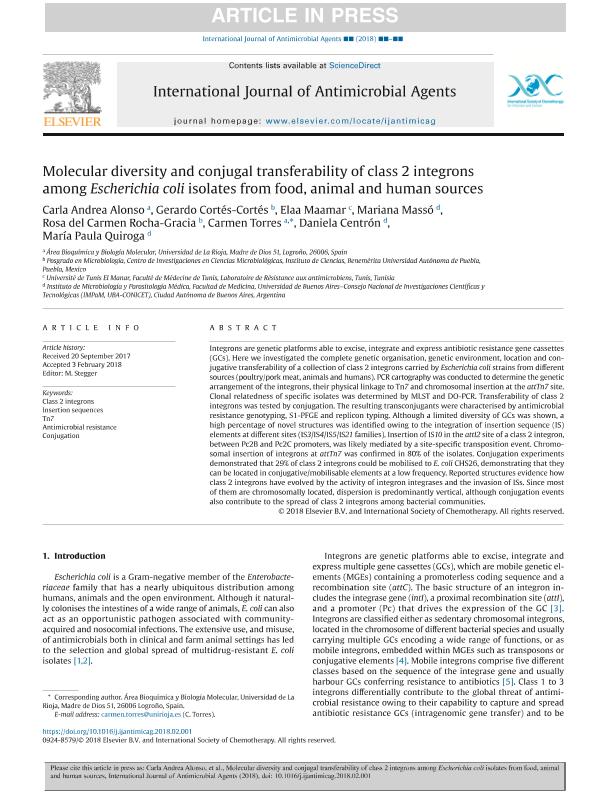Mostrar el registro sencillo del ítem
dc.contributor.author
Alonso, Carla Andrea
dc.contributor.author
Cortés Cortés, Gerardo
dc.contributor.author
Maamar, Elaa
dc.contributor.author
Masso, Mariana Guillermina

dc.contributor.author
Rocha Gracia, Rosa del Carmen
dc.contributor.author
Torres, Carmen
dc.contributor.author
Centron, Daniela

dc.contributor.author
Quiroga, María Paula

dc.date.available
2019-10-22T18:47:53Z
dc.date.issued
2018-06
dc.identifier.citation
Alonso, Carla Andrea; Cortés Cortés, Gerardo; Maamar, Elaa; Masso, Mariana Guillermina; Rocha Gracia, Rosa del Carmen; et al.; Molecular diversity and conjugal transferability of class 2 integrons among Escherichia coli isolates from food, animal and human sources; Elsevier Science; International Journal of Antimicrobial Agents; 51; 6; 6-2018; 905-911
dc.identifier.issn
0924-8579
dc.identifier.uri
http://hdl.handle.net/11336/86961
dc.description.abstract
Integrons are genetic platforms able to excise, integrate and express antibiotic resistance gene cassettes (GCs). Here we investigated the complete genetic organisation, genetic environment, location and conjugative transferability of a collection of class 2 integrons carried by Escherichia coli strains from different sources (poultry/pork meat, animals and humans). PCR cartography was conducted to determine the genetic arrangement of the integrons, their physical linkage to Tn7 and chromosomal insertion at the attTn7 site. Clonal relatedness of specific isolates was determined by MLST and DO-PCR. Transferability of class 2 integrons was tested by conjugation. The resulting transconjugants were characterised by antimicrobial resistance genotyping, S1-PFGE and replicon typing. Although a limited diversity of GCs was shown, a high percentage of novel structures was identified owing to the integration of insertion sequence (IS) elements at different sites (IS3/IS4/IS5/IS21 families). Insertion of IS10 in the attI2 site of a class 2 integron, between Pc2B and Pc2C promoters, was likely mediated by a site-specific transposition event. Chromosomal insertion of integrons at attTn7 was confirmed in 80% of the isolates. Conjugation experiments demonstrated that 29% of class 2 integrons could be mobilised to E. coli CHS26, demonstrating that they can be located in conjugative/mobilisable elements at a low frequency. Reported structures evidence how class 2 integrons have evolved by the activity of integron integrases and the invasion of ISs. Since most of them are chromosomally located, dispersion is predominantly vertical, although conjugation events also contribute to the spread of class 2 integrons among bacterial communities.
dc.format
application/pdf
dc.language.iso
eng
dc.publisher
Elsevier Science

dc.rights
info:eu-repo/semantics/openAccess
dc.rights.uri
https://creativecommons.org/licenses/by-nc-sa/2.5/ar/
dc.subject
ANTIMICROBIAL RESISTANCE
dc.subject
CLASS 2 INTEGRONS
dc.subject
CONJUGATION
dc.subject
INSERTION SEQUENCES
dc.subject
TN7
dc.subject.classification
Bioquímica y Biología Molecular

dc.subject.classification
Ciencias Biológicas

dc.subject.classification
CIENCIAS NATURALES Y EXACTAS

dc.title
Molecular diversity and conjugal transferability of class 2 integrons among Escherichia coli isolates from food, animal and human sources
dc.type
info:eu-repo/semantics/article
dc.type
info:ar-repo/semantics/artículo
dc.type
info:eu-repo/semantics/publishedVersion
dc.date.updated
2019-10-10T14:58:22Z
dc.identifier.eissn
1872-7913
dc.journal.volume
51
dc.journal.number
6
dc.journal.pagination
905-911
dc.journal.pais
Países Bajos

dc.journal.ciudad
Amsterdam
dc.description.fil
Fil: Alonso, Carla Andrea. Universidad de la Rioja; España
dc.description.fil
Fil: Cortés Cortés, Gerardo. Benemérita Universidad Autónoma de Puebla; México
dc.description.fil
Fil: Maamar, Elaa. University Of Tunis El Manar; Túnez
dc.description.fil
Fil: Masso, Mariana Guillermina. Consejo Nacional de Investigaciones Científicas y Técnicas. Oficina de Coordinación Administrativa Houssay. Instituto de Investigaciones en Microbiología y Parasitología Médica. Universidad de Buenos Aires. Facultad de Medicina. Instituto de Investigaciones en Microbiología y Parasitología Médica; Argentina
dc.description.fil
Fil: Rocha Gracia, Rosa del Carmen. Benemérita Universidad Autónoma de Puebla; México
dc.description.fil
Fil: Torres, Carmen. Universidad de la Rioja; España
dc.description.fil
Fil: Centron, Daniela. Consejo Nacional de Investigaciones Científicas y Técnicas. Oficina de Coordinación Administrativa Houssay. Instituto de Investigaciones en Microbiología y Parasitología Médica. Universidad de Buenos Aires. Facultad de Medicina. Instituto de Investigaciones en Microbiología y Parasitología Médica; Argentina
dc.description.fil
Fil: Quiroga, María Paula. Consejo Nacional de Investigaciones Científicas y Técnicas. Oficina de Coordinación Administrativa Houssay. Instituto de Investigaciones en Microbiología y Parasitología Médica. Universidad de Buenos Aires. Facultad de Medicina. Instituto de Investigaciones en Microbiología y Parasitología Médica; Argentina
dc.journal.title
International Journal of Antimicrobial Agents

dc.relation.alternativeid
info:eu-repo/semantics/altIdentifier/url/https://www.sciencedirect.com/science/article/pii/S0924857918300396
dc.relation.alternativeid
info:eu-repo/semantics/altIdentifier/doi/https://doi.org/10.1016/j.ijantimicag.2018.02.001
Archivos asociados
